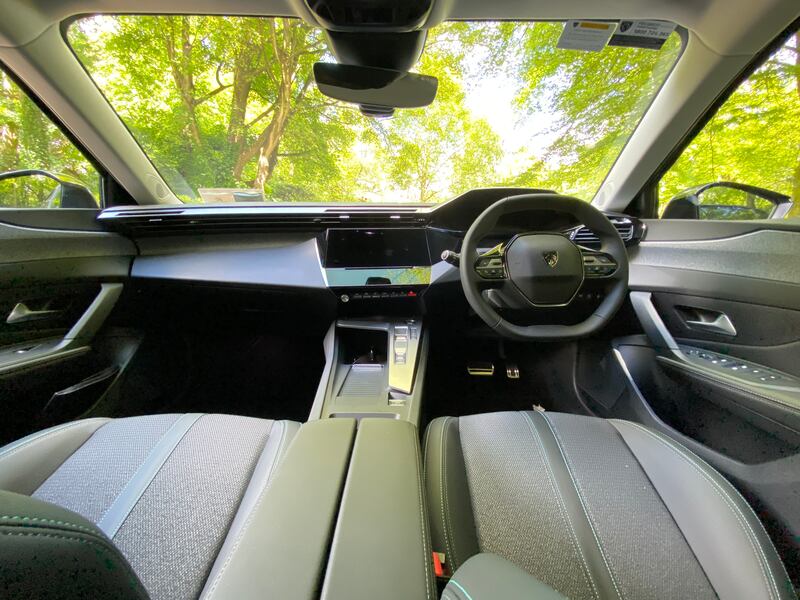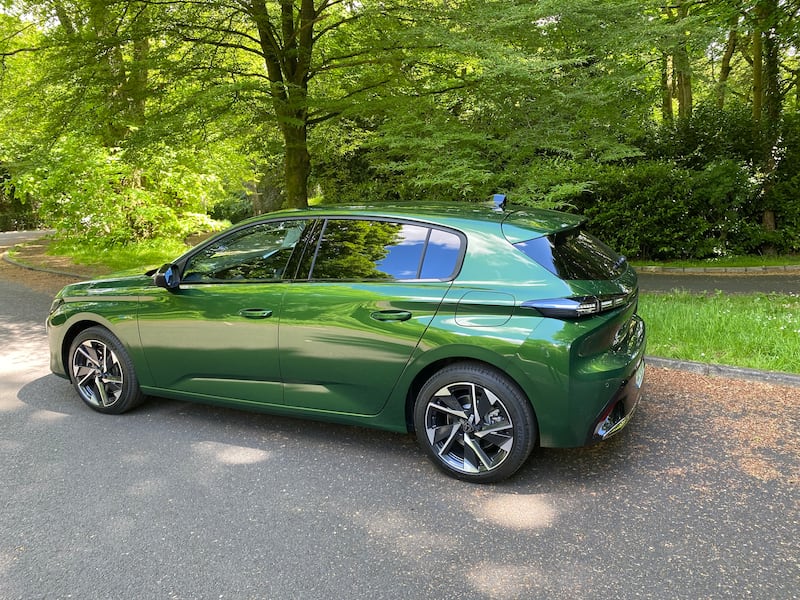It was long ago that Peugeot made its own suspension components. Dampers. Springs. MacPherson struts. That sounds a bit nebulous — don’t all car makers make their own suspension? Well, no actually. For the most part such components are bought in from outside suppliers, made to a spec by the lowest bidder. Peugeot, though, cared about how its cars rode and handled, and wanted to keep control of that process. So it made its own bits, and when we drove cars — brilliant cars — such as the old 205, 405, 406, 306, you could see the value of such things.
Peugeot dropped the dynamic ball, big time, in the early 2000s, with the mediocre likes of the 307 and first-generation 308, but over the past decade or so, the French car maker has clawed (no lion-based pun intended) back into handling contention.
This new 308 copper-fastens that resurgence. It’s not that it’s an unbelievably brilliant car to drive, one that runs steering and feedback rings around its opposition — it’s not — but it is a car that has a wonderfully complete feel to how it drives, a sense that all of its components are working in harmony.
You’ll notice how it looks first, of course. In the current Peugeot styling idiom, it’s striking, almost aggressive, and looks especially good in the gorgeous metallic green of our test car. It is, arguably, a little over the top in some of its details, but then that’s the current trend, so one can hardly take issue with Peugeot for that.
READ MORE
Inside, it retains the high-instruments, low-wheel layout of all recent Peugeots. Some drivers, depending on their height, will simply not be able to gel with it, but I (just over six feet) quite like it. The seats are great, but the steering wheel — small, almost hexagonal and sat in your lap — is offset annoyingly to the right. On the upside, apart from a few cheaper-looking plastics, the cabin is really well built, with a high-quality feel.

There’s also been a big improvement in the screens. Compared with its predecessor (and even some of its stablemates) this 308 gets impressive new software that looks slick on the screen, and is easier than that of some rivals (cough-Volkswagen-cough) to find your way around. There are some physical shortcut keys, as before, and from mid-range Allure specification and above, a rank of easily customised touch-sensitive buttons below the screen that also bring you more quickly to major menu items. The heating controls are still way too fiddly, though, but at least there is a physical knob for the stereo volume.
The main digital instruments have also been given a slick new look, but they do look a little small. Or perhaps, Father Ted-style, they’re just slightly farther away.
Your back-seat passengers will not be farther away. Even though this 308 has a longer wheelbase than the notoriously cramped previous version, legroom is still a touch tight, although headroom is okay. You do, at least, get more rear-seat space than in a rival Toyota Corolla.
And the Corolla is a direct rival now, as this 308 comes in hybrid (actually plug-in hybrid) form. This Allure model we’re testing gets a 180hp system, based around the familiar 1.6-litre THP turbo charged petrol engine. You can, if you prefer, opt for a base 130hp 1.2-litre petrol with no hybrid, or even a 1.5 diesel if you’re one of the few who still visit the black pump. At the top of the range, in GT spec, there’s also a more powerful 225hp plug-in hybrid.
I doubt you’d need the extra power, to be honest. Although this 180hp version displays an annoying habit of wait-wait-wait-here-we-go power delivery when you ask for acceleration, in all other respects it’s more than up to the job. It’s exceptionally refined, for the most part, only really raising its voice above acceptable levels when you ask for a sudden burst of power from low speeds. Fill up the 12.4kWh battery with electrons, and the 308 can run for a claimed 60km (and a likely real-world 45-50km) on battery power alone.

Better yet, it bucks the older plug-in hybrid trend of vicious thirst on longer journeys — on one two-hour motorway run, with a depleted battery, we recorded 5.6-litres per 100km average consumption, which is pretty good. Actually, the only real hybrid compromise we could detect was in the boot, which shrinks from a capacious 412-litres in the petrol or diesel model to just 361-litres here. There is a roomy estate version coming soon, so go for that if you need the extra space.
Did we say the only compromise? Well, not quite — the price is a bit of a compromise. Prices for the new 308 start at a stiff €31,765 and that’s for a basic Active model with the 1.2-litre engine. If you want this hybrid version, in Allure spec, you’ll need to pay €44,325. For comparison’s sake, a top-spec Toyota Corolla in GR Sport form costs €34,065, albeit it’s a hybrid rather than a plug-in hybrid. A slightly fairer comparison would be with the Volkswagen Golf e-Hybrid, which has a retail price of €44,270, which we guess makes the Peugeot seem a little more reasonable.
The drive makes it almost seem worth it. While the 308 won’t challenge the likes of the Ford Focus and Mazda 3 in the outright handling and feel stakes, it feels like a seriously well-sorted car on the road. The steering is a touch light and numb, but it’s quick and makes the 308 feel enjoyably agile. There is body roll, but the pay-off for that is a superbly well-damped ride quality that’s only really ever upset by washboard urban surfaces. At all other times, it’s really very comfortable, with good levels of refinement too, thanks in part to double-glazed front windows.
The new 308 doesn’t merely show that Peugeot has returned, somewhat, to its old enthusiast-pleasing days of sharp chassis tuning. More than that, it shows that a French car can be not only stylish and comfortable but can match its German and Japanese rivals when it comes to technology and sophistication. Even with relatively high prices, that sounds like a good deal to us.












